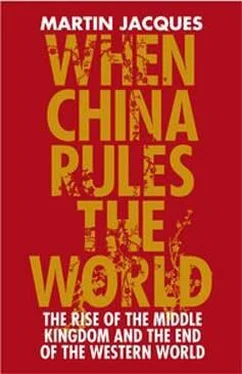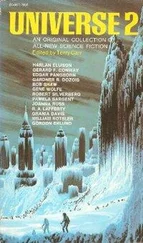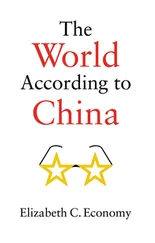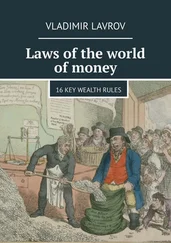Total population is only one aspect of the effect of China ’s scale. The second is the size of its labour force. Although China ’s population presently accounts for 21 per cent of the world’s total, the proportion of the global labour force that it represents is, at 25 per cent, slightly higher. In 1978, when the great majority of its people worked on the land, China only had 118 million non-agricultural labourers. In 2002 that figure had already increased to 369 million, compared with a total of 455 million in the developed world. By 2020 it is estimated that there will be 533 million non-agricultural labourers in China, by which time it will exceed the equivalent figure for the whole of the developed world by no less than 100 million. In other words, China’s growth is leading to a huge increase in the number of people engaged in non-agricultural labour and, as a consequence, is providing a massive — and very rapid — addition to the world’s total non-agricultural labour force.
The third effect of China ’s rise concerns the impact of its economic scale on the rest of the world. China ’s average annual rate of growth of GDP since 1978 has been 9.4 per cent, over twice the US ’s growth rate of 3.94 per cent between 1870 and 1913. It is projected that the duration of their respective take-offs may be roughly similar: 43 years in the case of the US, 42 years for China, because, although the latter’s growth rate is much faster, its population is also far larger. When the US commenced its take-off in 1870, its GDP accounted for 8.8 per cent of the world’s total, rising to 18.9 per cent by 1913. In contrast, China ’s GDP represented 4.9 per cent of the world’s total in 1978, but is likely to rise to 18–20 per cent by 2020. In both instances, their GDP growth has had a major impact on the expansion of global GDP. In the 1980s, for example, the United States made the biggest single contribution of any country, accounting for 21 per cent of the world’s total increase; in the 1990s, however, China, even at its present limited level of development, surpassed the US, which remained at 21 per cent, while China contributed 27.1 per cent to the growth of global GDP.
The fourth effect is the impact China will have on world trade. Before the Open Door policy, China was one of the world’s most closed economies. In 1970 its export trade made up only 0.7 per cent of the world’s total: at the end of the seventies, China ’s imports and exports together represented 12 per cent of its GDP, the lowest in the world. China ’s economic impact on the rest of the world was minimal for two reasons: firstly, the country was very poor, and secondly, it was very closed. But since 1978 China has rapidly become one of the world’s most open economies. Its average import tariff rate will decline from 23.7 per cent in 2001 to 5.7 per cent in 2011, with most of that fall having already taken place. [559] [559] Yu Yongding, ‘The Interactions between China and the World Economy’, p. 4.
Although its trade dependency (the proportion of GDP accounted for by exports and imports) was less than 10 per cent in 1978, by 2004 it had risen to 70 per cent, much higher than that of other large countries. China has now overtaken the United States to become the second largest exporter in the world, while in 2004 it ranked as the world’s third largest importer, accounting for 5.9 per cent of the global total. By 2010 a developing country, in the shape of China, will for the first time become the world’s biggest trader.
Each of these scale effects — population, labour, economy and trade — clearly has a mainly positive impact on the rest of the world, stimulating overall global growth and the expansion of national economies. But the fifth effect, China’s consumption of resources, has a largely negative global impact: because the country is so poorly endowed with natural resources, its population so enormous and its economic development so intensive, its demand for natural resources has the double effect of raising the price of raw materials and depleting the world’s stock of them, a process that, on the basis of recent trends, is likely to accelerate in the future.
CHINA’S GLOBAL ECONOMIC IMPACT
Although China remains a poor country, its per capita GDP only reaching $1,000 in 2003, it is already having a profound impact on the world. Along with the United States it has been the main engine of global economic growth, contributing no less than one-third of the world’s growth in real output between 2002 and 2005. It has been widely credited with having pulled Japan out of its long-running post-bubble recession, having been responsible for two-thirds of the growth in Japan ’s exports and one-quarter of its real GDP growth in 2003 alone. [560] [560] ‘The Dragon and the Eagle Survey’, The Economist , 2 October 2004, p. 29.
The emergence of China as the world’s cheapest producer of manufactured goods has resulted in a sharp global drop in their prices. The price of clothing and shoes in the US, for example, has fallen by 30 per cent over the last decade. Major gainers from this have been consumers in the developed world, while the rise in commodity prices consequent upon Chinese demand had a beneficial effect on primary producers — many of which are based in the developing world — until the global downturn intervened. Anxious to secure sufficient supplies of raw materials to fuel its booming economy, China has been highly active in Africa, Latin America and the Middle East, concluding major agreements with Iran, Venezuela and the Sudan amongst many others. Another net gainer has been Russia, which is a major producer of many commodities, notably oil and gas; and, though rather less trumpeted, Australia. It is China ’s shortage of raw materials that has driven a major diplomatic offensive with many African and Latin American countries, including the ambitious China- Africa summit in Beijing in November 2006. [561] [561] See, for example, Roger F. Noriega, ‘China’s Influence in the Western Hemisphere’, statement before the House Sub-committee on the Western Hemisphere, Washington, DC, 16 April 2005; Prestowitz, Three Billion New Capitalists , p. 241; and Leni Wild and David Mepnam, eds, The New Sinosphere: China in Africa (London: Institute for Public Policy Research, 2006).
The main losers have been those developing countries, like Mexico, whose comparative advantage lies in similar labour-intensive production and that find themselves in direct competition with China. [562] [562] Prestowitz, Three Billion New Capitalists , p. 240; Shenkar, The Chinese Century , p. 110; ‘Latin Textile Makers Feel Chinese Pressure’, International Herald Tribune , 2 April 2007.
They have also lost out to China in terms of foreign direct investment, with many international firms relocating their operations from these countries to China. The other obvious losers are blue-collar workers in the developed world who have found their jobs being outsourced to China.
By far the greatest impact of China ’s rise has been felt in East Asia. The main gainers have been the developed Asian tigers of North-East Asia — South Korea and Taiwan, together with Japan. They have been the beneficiaries of cheap manufactured goods produced in China while at the same time enjoying growing demand from China for their knowledge and capital-intensive products. [563] [563] Prestowitz, Three Billion New Capitalists , p. 137.
Their own companies have relocated many of their operations to China to take advantage of much cheaper labour, as in the case of the Taiwanese computer industry. [564] [564] Ibid., p. 199.
The losers have been the same as those in the West, namely those workers displaced by operations outsourced to China. Unlike the United States, which has a huge trade deficit with China, all of these countries enjoy large surpluses with China. The nearest example in the region to a grey area is South-East Asia, whose economies are not so dissimilar to that of China, though Singapore and Malaysia, in particular, are rather more developed. Over the last decade, the ASEAN countries have seen a large slice of the foreign direct investment they previously received going to China. They have also lost out to China in the mass assembly of electronic and computer equipment — Singapore and Malaysia being notable examples — and have, as a consequence, been forced to move up the value chain in to order to escape Chinese competition. [565] [565] Shenkar, The Chinese Century , p. 113.
The country that has suffered the greatest is Indonesia, whose economy most closely resembles that of China. Indonesia has lost out to China in terms of direct investment by foreign multinationals, which have opted for China rather than Indonesia as their preferred production base. On balance, however, China’s growth has greatly benefited the ASEAN countries too, with China now comfortably ensconced as their largest trading partner, one of their biggest markets (if not the biggest), and in many cases their main provider of inward investment. [566] [566] Gary Clyde Hufbauer and Yee Wong, ‘Prospects for Regional Free Trade in Asia’, working paper, Institute for International Economics, Washington, DC, October 2005, p. 4; Prestowitz, Three Billion New Capitalists , p. 226.
Читать дальше












